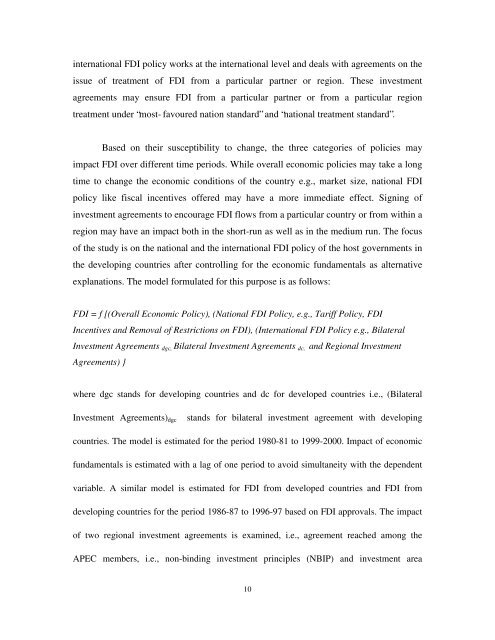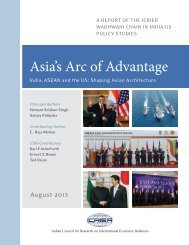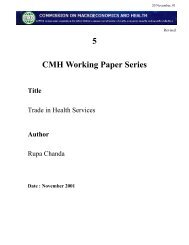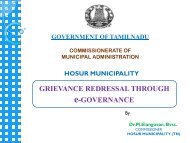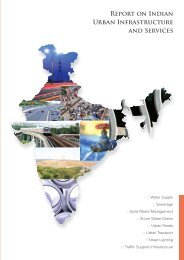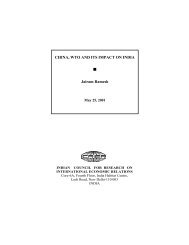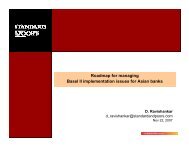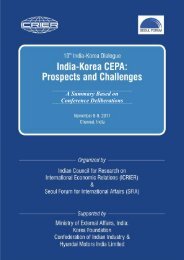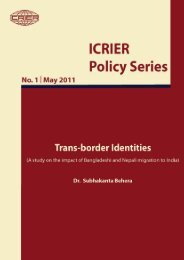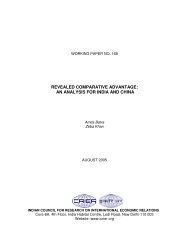impact of government policies and investment agreements on fdi ...
impact of government policies and investment agreements on fdi ...
impact of government policies and investment agreements on fdi ...
Create successful ePaper yourself
Turn your PDF publications into a flip-book with our unique Google optimized e-Paper software.
internati<strong>on</strong>al FDI policy works at the internati<strong>on</strong>al level <str<strong>on</strong>g>and</str<strong>on</strong>g> deals with <str<strong>on</strong>g>agreements</str<strong>on</strong>g> <strong>on</strong> the<br />
issue <str<strong>on</strong>g>of</str<strong>on</strong>g> treatment <str<strong>on</strong>g>of</str<strong>on</strong>g> FDI from a particular partner or regi<strong>on</strong>. These <str<strong>on</strong>g>investment</str<strong>on</strong>g><br />
<str<strong>on</strong>g>agreements</str<strong>on</strong>g> may ensure FDI from a particular partner or from a particular regi<strong>on</strong><br />
treatment under “most- favoured nati<strong>on</strong> st<str<strong>on</strong>g>and</str<strong>on</strong>g>ard” <str<strong>on</strong>g>and</str<strong>on</strong>g> “nati<strong>on</strong>al treatment st<str<strong>on</strong>g>and</str<strong>on</strong>g>ard”.<br />
Based <strong>on</strong> their susceptibility to change, the three categories <str<strong>on</strong>g>of</str<strong>on</strong>g> <str<strong>on</strong>g>policies</str<strong>on</strong>g> may<br />
<str<strong>on</strong>g>impact</str<strong>on</strong>g> FDI over different time periods. While overall ec<strong>on</strong>omic <str<strong>on</strong>g>policies</str<strong>on</strong>g> may take a l<strong>on</strong>g<br />
time to change the ec<strong>on</strong>omic c<strong>on</strong>diti<strong>on</strong>s <str<strong>on</strong>g>of</str<strong>on</strong>g> the country e.g., market size, nati<strong>on</strong>al FDI<br />
policy like fiscal incentives <str<strong>on</strong>g>of</str<strong>on</strong>g>fered may have a more immediate effect. Signing <str<strong>on</strong>g>of</str<strong>on</strong>g><br />
<str<strong>on</strong>g>investment</str<strong>on</strong>g> <str<strong>on</strong>g>agreements</str<strong>on</strong>g> to encourage FDI flows from a particular country or from within a<br />
regi<strong>on</strong> may have an <str<strong>on</strong>g>impact</str<strong>on</strong>g> both in the short-run as well as in the medium run. The focus<br />
<str<strong>on</strong>g>of</str<strong>on</strong>g> the study is <strong>on</strong> the nati<strong>on</strong>al <str<strong>on</strong>g>and</str<strong>on</strong>g> the internati<strong>on</strong>al FDI policy <str<strong>on</strong>g>of</str<strong>on</strong>g> the host <str<strong>on</strong>g>government</str<strong>on</strong>g>s in<br />
the developing countries after c<strong>on</strong>trolling for the ec<strong>on</strong>omic fundamentals as alternative<br />
explanati<strong>on</strong>s. The model formulated for this purpose is as follows:<br />
FDI = f [(Overall Ec<strong>on</strong>omic Policy), (Nati<strong>on</strong>al FDI Policy, e.g., Tariff Policy, FDI<br />
Incentives <str<strong>on</strong>g>and</str<strong>on</strong>g> Removal <str<strong>on</strong>g>of</str<strong>on</strong>g> Restricti<strong>on</strong>s <strong>on</strong> FDI), (Internati<strong>on</strong>al FDI Policy e.g., Bilateral<br />
Investment Agreements dgc, Bilateral Investment Agreements dc, <str<strong>on</strong>g>and</str<strong>on</strong>g> Regi<strong>on</strong>al Investment<br />
Agreements) }<br />
where dgc st<str<strong>on</strong>g>and</str<strong>on</strong>g>s for developing countries <str<strong>on</strong>g>and</str<strong>on</strong>g> dc for developed countries i.e., (Bilateral<br />
Investment Agreements) dgc<br />
st<str<strong>on</strong>g>and</str<strong>on</strong>g>s for bilateral <str<strong>on</strong>g>investment</str<strong>on</strong>g> agreement with developing<br />
countries. The model is estimated for the period 1980-81 to 1999-2000. Impact <str<strong>on</strong>g>of</str<strong>on</strong>g> ec<strong>on</strong>omic<br />
fundamentals is estimated with a lag <str<strong>on</strong>g>of</str<strong>on</strong>g> <strong>on</strong>e period to avoid simultaneity with the dependent<br />
variable. A similar model is estimated for FDI from developed countries <str<strong>on</strong>g>and</str<strong>on</strong>g> FDI from<br />
developing countries for the period 1986-87 to 1996-97 based <strong>on</strong> FDI approvals. The <str<strong>on</strong>g>impact</str<strong>on</strong>g><br />
<str<strong>on</strong>g>of</str<strong>on</strong>g> two regi<strong>on</strong>al <str<strong>on</strong>g>investment</str<strong>on</strong>g> <str<strong>on</strong>g>agreements</str<strong>on</strong>g> is examined, i.e., agreement reached am<strong>on</strong>g the<br />
APEC members, i.e., n<strong>on</strong>-binding <str<strong>on</strong>g>investment</str<strong>on</strong>g> principles (NBIP) <str<strong>on</strong>g>and</str<strong>on</strong>g> <str<strong>on</strong>g>investment</str<strong>on</strong>g> area<br />
10


